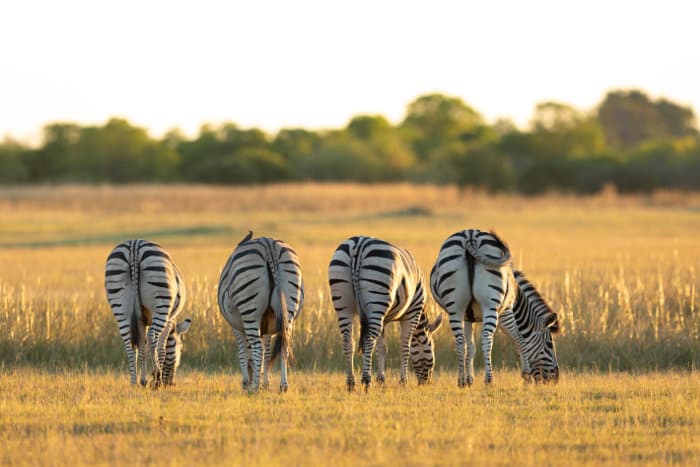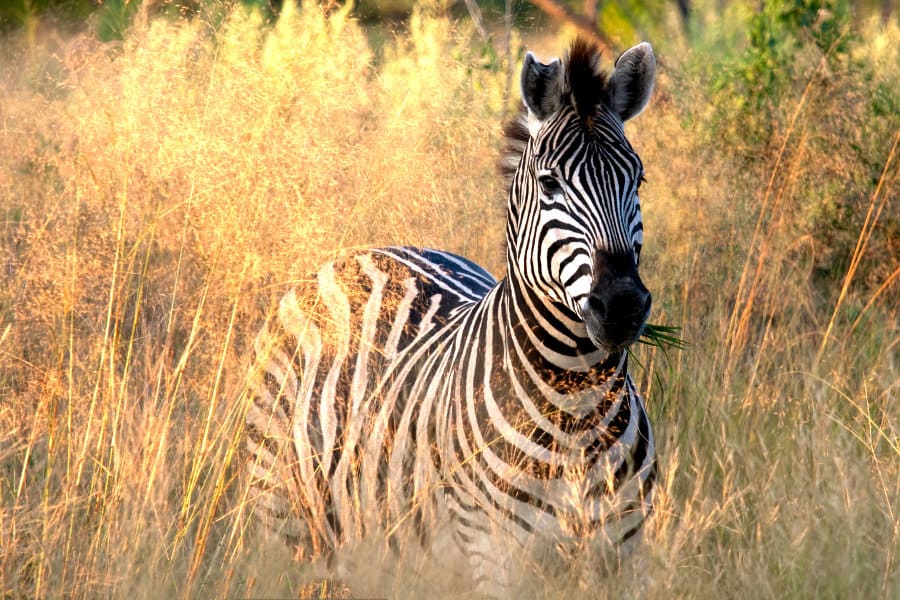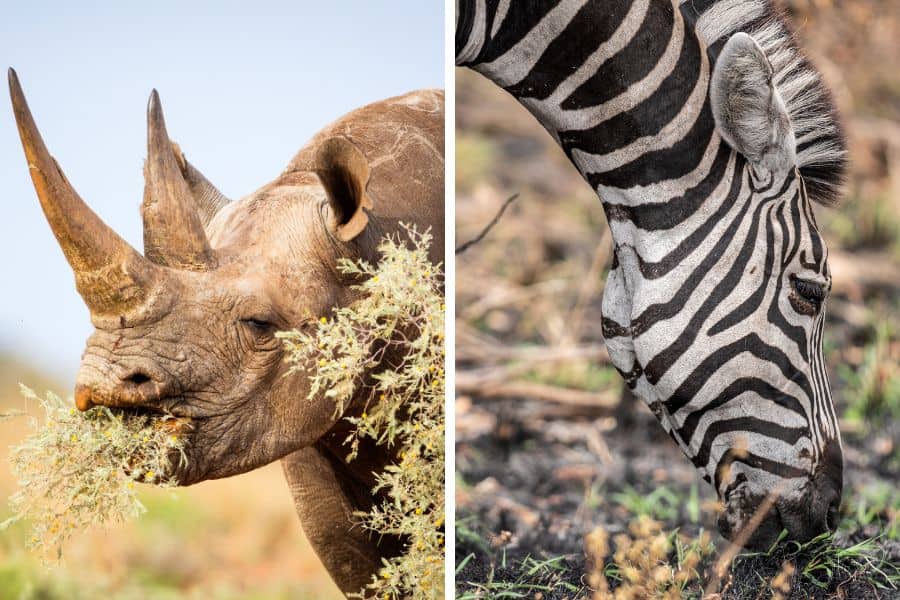In case any of you were wondering, zebras are actually black with white stripes, as opposed to white with black stripes. These funky mammals with intricate stripes and patterns are pretty spectacular. Are their diets just as incredible?
For most of us, a diet of grass doesn’t sound too appealing. However, these mammals couldn’t imagine life without it. As an important source of fiber and nutrients, found throughout their habitats, it provides great levels of energy and sustenance.
It doesn’t only fuel their lifestyle out in the plains of Africa. By grazing on the velds, zebras also play an important part in the ecosystem.
Nonetheless, there’s more to their eating habits than you might think. Read on for the full scoop.
Is a Zebra a Herbivore?

Or are zebras omnivores? To answer your question, they are in fact herbivores. Being herbivores means that they only eat plants – grass in particular. Although, that’s not to say that they won’t find alternatives to grass if conditions are unfavorable.
Grass makes up 90% of their diets. It’s a good thing that there isn’t just one type of grass. In Africa, there are hundreds of species. This allows a wide variety of herbivores to thrive in the same area, enjoying different varieties of grass.
You might find a herd of zebras integrated with buffalo, wildebeest, and antelope. This is because they have similar diets and eating patterns. They often migrate as a team, too, like in the annual great wildebeest migration.
Do zebras eat meat?
Zebras don’t eat any meat. This seems fair. They’ve probably spent centuries trying to outrun lions and they know what it’s like to be on the receiving end of predation. Their teeth wouldn’t do a good job of eating meat, and their stomachs couldn’t even attempt to digest it.
Zebras’ Eating Patterns

Zebras spend a whopping 60-80% of their waking day grazing. With specialized teeth, it doesn’t take a toll on their bodies. Their front teeth are a lot sharper in order to easily slice off the strands of grass. While their back teeth do all the grinding and chomping.
Given that lions and cheetahs find these animals particularly delicious, zebras have to constantly be on the lookout. Part of their evolution has allowed these animals to stand up grazing, which is perfect for a quick escape.
Eating in a herd is a huge part of their success. At any given time there are at least a few of them with their heads held high, looking out for predators. If they spot one, they alert the rest with a high pitched bray.
What do zebra eat in a zoo?
Zoo food is completely different from what zebras eat in the wild. While wild zebras graze throughout the day, in captivity they usually only eat once a day. The reason they don’t have to feed throughout the day is that the Timothy hay (special zoo food) is higher in nutrients.
They are also fed special pellets, with the mammal’s dietary specifications kept in mind. These pellets contain added nutrients and supplements to keep them healthy.
Zoos also provide a salt lick for the animals, which they can lick on whenever they please. In the wild, zebras feast on a lot of grass rich in salt. They are also often given treats like carrots, apples, and sugar cubes.
Let’s take a look at what zebras eat during a day

Red grass is one of the dominating grasses on the savanna plains. Making it a great choice for zebras to enjoy. Bermuda grass is commonly found along the river beds – a tasty treat, too. They also enjoy the most widespread of the short grasses; common finger grass.
There are three popular species of zebra that wander around the different regions of Africa. Meaning that they’re each going to come across different grass types and have their own personal preference.
- Mountain zebra: Having to brave out the mountainous landscapes, this zebra has well-adapted hooves. The strong hooves dig for water and uproot tufty roots. Red oat grass is their main source of food, while they also enjoy Cymbopogon plurinodis grass.
- Grevy’s zebra: Grevy’s zebras diet on grasses that are a lot coarser and tougher than most grass types. Such as Eleusine jaegeri and Pennisetum schimperi, which other zebras don’t favor. During the dry season, they eat a lot of foliage and bark.
- Common zebra: The common zebra, also known as the ‘plains zebra’, is continuously on the search for lush grasslands, with young grass. The shorter and greener it is, the better. They are adaptable though. In the arid months, they can survive just fine off of dry, rough grasses. Red oat grass, Cenchrus ciliaris and Eragrostis superba are common grasses the plains zebra eats.
What do zebras drink?
Zebras need a lot of water to withstand the harsh African sun and drier months of winter. In these dry periods, they will migrate or follow the rains. They can travel up to 1100 km in search of fresh grazing and drinking grounds.
In one sitting, a zebra alone can drink almost four liters of water. That’s more than double than what an average human would drink throughout the entire day. Wild zebras can survive for up to five days without water, which is a brilliant survival trait for the seasons of drought.
What Do Zebras Eat During a Drought?

Due to the harsh climate in Africa, the mammals here have to be well-prepared for periods with low rainfall. Not only does this result in having less access to water, it also means that grasslands are unable to retain nutrients.
Animals can forget about lush fields of green grass for a while. Rather, it’s dried, low-nutrient plants on the menu. And while this might be detrimental to other herbivores like cows, the zebra is able to survive on dried-out grasses.
If there is no suitable grass, zebras will happily eat flowers, herbs, hardy shrubs, twigs, bark, and legumes.
Zebra Digestive System
While they may be similar in appearance to horses, a zebra has a specialized digestive system built for Africa. This allows them to digest the hardier plants more efficiently than others.
Herbivores like cows make use of multiple-chambered stomachs that process the grass. Zebras have single-chambered stomachs, which use a process called hindgut fermentation. This process of fermentation involves beneficial bacteria breaking down the fibrous plant matter.
Rabbits and rhinos are two other species in Africa that utilize this fermentation process.
Baby Zebras’ Food

You call a baby zebra a foal, and if you thought baby horses were cute, you’re in for a surprise.
Zebras have a 12-13 month gestation period. Once born, these playful, clumsy, and curious foals receive nourishment from their mother’s milk for an entire year.
The foal will start eating soft blades of grass from as young as one week. Between 7 and 11 months, they will slowly wean off of their mother’s milk and move onto grass alone.
Fun fact: when baby zebras are born, they have brown and white stripes, not black and white.
What Would We Do Without Zebras Eating Grass?
For centuries zebras have featured in cave rock art, traditional stories, and nature photography. As well as being subjects for painting, and even used as a symbol of peace.
So what would happen if we didn’t have these wild animals grazing on grasslands? It wouldn’t only affect our society, it would have detrimental effects on the environment. Without these animals eating the grass, there would be so much more for other herbivores.
This could lead to less competition for food and habitat, and other species becoming too populous. Everything has a consequence. Like too many wildebeest becoming too destructive and causing deforestation.
It would also mean less zebra poop. Poop which nourishes the soil and allows for more grass to grow.
If there were no zebra, the tiny oxpecker bird that is usually seen perched on a zebra would have one less source of food. The same goes for lions. They’d have a much harder time trying to catch wildebeest and buffalo.
What Makes a Zebra Diet So Special?

People recognize the dazzling stripes of a zebra in all parts of the world. They form a large part of many African cultures’ designs, as well as traditional stories, told around the fire. We also know that they’re a lion’s cherished meal.
Yet, so many of us brush past the question ‘what does a zebra eat?’. We have a rough idea, of course, however, we don’t realize how fascinating their diets really are. Who knew that they were able to digest low-nutrient grasses that other herbivores can’t? Or that they can drink 4 liters of water in one sitting?
Take the chance to see these mammals out in the wild, munching the days away. They’re often spotted near fellow herbivores like giraffes, rhinos, impala, and warthogs. Book yourself a personalized safari tour to spy upon these camouflaged horses – you won’t regret it.



